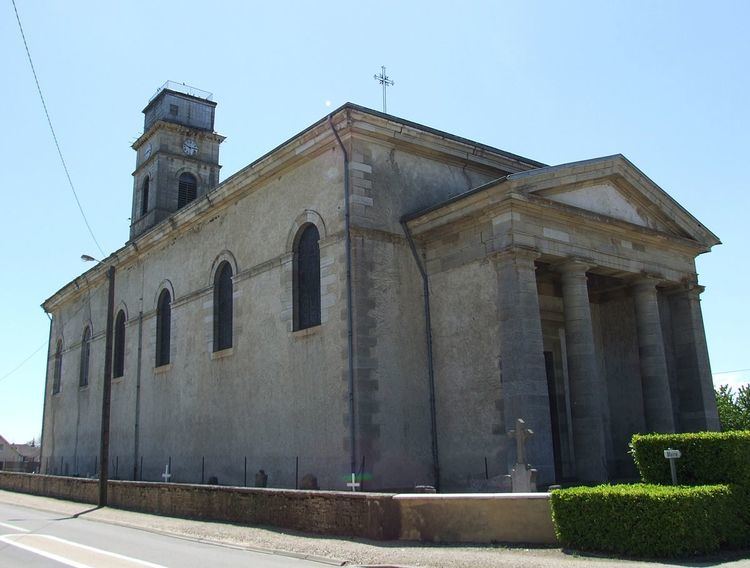Population (2009) 2,471 Local time Tuesday 8:38 AM | Intercommunality Plaine des Tilles Area 22.71 km² | |
 | ||
Region Bourgogne-Franche-Comté Weather 6°C, Wind S at 19 km/h, 79% Humidity | ||
Arc-sur-Tille is a French commune in the Côte-d'Or department in the Bourgogne-Franche-Comté region of eastern France.
Contents
- Map of 21560 Arc sur Tille France
- Geography
- Geology
- Hydrography
- History
- Administration
- Demography
- Civil Heritage
- Religious Heritage
- Notable people linked to the commune
- References
Map of 21560 Arc-sur-Tille, France
The inhabitants of the commune are known as Acétillois or Acétilloises
Geography
Arc-sur-Tille is located approximately 12 kilometres by road east of Dijon by road D70 which continues north-west to Magny-Saint-Medard. The A31 autoroute passes through the west of the commune from north to south with exit 4 in the commune west of the town. The commune can also be accessed from Remilly-sur-Tille in the south by road D34 which continues north to Chateau d'Arcelot. Road D961 also goes east from the village to Étevaux. Apart from the large sized village occupying some 15% of the commune, the rest of the area is almost entirely farmland.
Geology
The commune is located on a marshy plain
Hydrography
The commune is traversed from north to south by the Tille, a tributary of the Saône. It has often flooded in the past, overwhelming and damaging the village and crops.
The Lake of Arc-sur-Tille, west of the town, is a former gravel pit converted since 2002 to create the largest sandy beach in Burgundy. It is very popular in summer with swimmers and it allows many water activities (sailing, canoeing, water skiing and fishing basins reserved). The lake water is of excellent quality.
History
The Arc-sur-Tille Parish in the 17th century had its name corrupted by the vulgar pronunciation Astille. The village was a bailiwick, revenue office, and storehouse for salt from Dijon. Depends on both the Bishop of Chalon-sur-Saône and the Archdeacon of Oscheret. Three-quarters of the tithe was for the lord and the rest for the priest. It was 11, 12, or 13 bundles of all kinds of grain.
The patron saint of the parish was Saint Martin, Archbishop of Tours, whose principal feast is not on 11 November, the day of his death, but on 4 July, the day of the Translation of his relics; the dedication of the church is celebrated the Sunday before 3 August.
Abbots from the Abbey of Saint-Étienne of Dijon have the right to preach at this church, from Gautier, Bishop of Chalon-sur-Saône who gave this right to them in 1117. Jotsalde or Joussaud, his successor in the bishopric, ratified this in the same year in a full synod of Tournus and it was subsequently confirmed by various popes in 1124, by Callistus II in 1139, by Innocent II, then in 1156, 1185, 1238, 1245 and 1290. This land with full justice rights was raised to a marquisate. The only trade was in coal. It grew wheat, barley, oats and conceau in vineyards and meadows that yielded a very bad hay. The 138 inhabitants were very poor except for three or four. In 1260 Henry de Vergy declared tenure in fief with allegiance to the Duke of Burgundy the fiefs of Bere, Arc-sur-Tille, and Janle. The village was given the name of a local family. Maifroi of Archo gave the enclosed land within the lordship of Arc to the abbot of Saint-Étienne and also gave him the right of heating from the wood in 1115.
It was in the 14th century that the last heir of the lordship, Jehanne d'Arc, took as her husband Eudes de Saulx and thus the land entered the House of Saulx-Tavannes where it still was in the 18th century. The levy cost the States the sum of 45,000 livres in 1614. Before the French Revolution there were four fairs a year: on 4 January, March, May, and September. In 1636 Arc was burned by Matthias Gallas and the castle was plundered and destroyed.
On 9 February 1650 near Arc there was a battle between the troops of the King, led by the Marquis de Tavannes and the Count, his nephew, who commanded those of the Prince of Conde, then a prisoner at Le Havre. The King was defeated and lost all his equipment.
Administration
List of Successive Mayors
(Not all data is known)
Demography
In 2009 the commune had 2,471 inhabitants. The evolution of the number of inhabitants is known from the population censuses conducted in the commune since 1793. From the 21st century, a census of communes with fewer than 10,000 inhabitants is held every five years, unlike larger towns that have a sample survey every year.
Sources : Ldh/EHESS/Cassini until 1962, INSEE database from 1968 (population without double counting and municipal population from 2006)
Civil Heritage
Religious Heritage
The Church of Saint Martin was built during the French Restoration (1820-1830) in the Neo-classical style. In 1989 the building was in such a state of disrepair that it had to close. The former municipality, despite opposition from religious authorities, had planned to demolish the building but due to the action of the UEPA association, the first installment of rehabilitation work was launched in April 2013. A national subscription was raised through the Heritage Foundation to enable the financing of the second phase of work that will eventually reopen the Church of Saint Martin to the public. The church contains several items that are registered as historical objects:
